Flying with your dog is exciting, but it takes a lot of planning. From gathering vet records to learning airline-specific rules, it is easy to become overwhelmed before you even leave the ground.
We’ve assembled must-know information in an easy-to-follow list, so you can know your canine will be comfy during the flight and get back to planning the fun parts of your adventure.
Check out the most important things to know before flying with your dog, below!
Flying with Your Dog: Key Takeaways
- It’s often possible to fly with your dog, but there are a number of things you’ll need to think about first. For example, some breeds aren’t allowed to fly, and it is always important to have your vet give your pet a clean bill of health before you even consider flying.
- There are things you’ll need to buy before boarding the flight with your dog. Among other things, you’ll need an airline-approved crate or carrier, and you may also need things like spare leashes and travel-friendly water bowls.
- You will need to set aside some time to prepare your dog for the flight. This not only includes things like acclimating your pooch to the crate he’ll be traveling in, but also giving him ample opportunities for exercise and pottying before the flight.
1. You Need to Talk to Your Vet
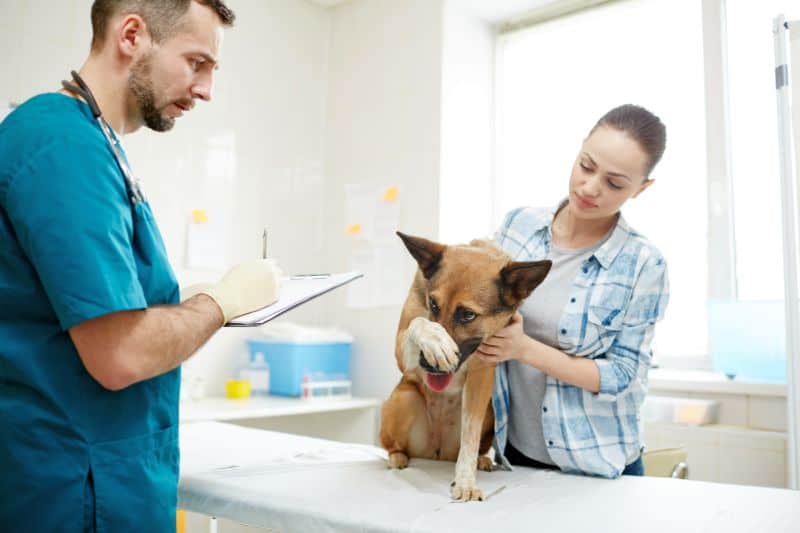
Most airlines require a health certificate before any animal can board a plane.
To acquire one, your dog needs a complete veterinary exam. The document typically states that your dog is healthy enough for travel, free of transmissible disease, and up-to-date on core vaccinations (such as rabies).
A key aspect of a health certificate is that it typically needs to be completed in a specific window before your flight. The time frame is generally within 10 days of flying, but this may vary by airline or destination.
To ensure you have the proper documentation, confirm the requirements with your airline in advance. Double-check that the document is signed and dated to prevent check-in disasters.
Beyond visiting the vet to get your paperwork in order, it’s also just plain necessary to have your dog’s health assessed before jetting off on an adventure. Travel is stressful on canines, both physically and mentally. It can even be dangerous for some doggos.
Specifically, older dogs and puppies may be too fragile to fly. The same is true for dogs suffering from certain health conditions, like heart disease. Brachycephalic (flat-faced) breeds are prone to breathing problems, which, paired with flying, can be deadly.
Always have your dog examined by a vet before travel and have an honest conversation regarding how safe flying is for him. A nose-to-tail examination can spot potential issues, allowing you to make an informed decision for your doggo.
2. Understand That Not All Dogs Like Flying

Flying isn’t every person’s cup of tea, and the same is true for doggos.
Some dogs don’t mind the hustle and bustle of the airport, followed by the loud trip into the sky, but the process can be downright terrifying for other dogs, especially for those with anxiety.
Put yourself in your pup’s shoes: Imagine traveling in a box, landing in a strange place and adjusting to its sights and smells, only to most likely go back in that same box a few days later to head home. All the while, you don’t know what’s going on.
You’re a dog. You don’t have an itinerary or understand the concept of a vacation. Talk about insane stress levels…
While we’d all love our four-footers to join us on every excursion, sometimes it’s best to let our dogs stay home. Hiring a dog sitter is a great option for canine care when you’re away, particularly for anxious dogs who typically don’t board well at kennels.
You can also try road tripping with your dog to your destination if it better fits his needs. Check out camping amenities or dog-friendly hotels within driving distance if you’d prefer to vacation with your dog without flying.
It’s important to note that not every dog likes to travel, regardless of the form of transportation. Your pup may be too anxious to travel via carrier and hurt himself by chewing or pawing at his crate. Other dogs that act aggressively may not be able to travel without risking the safety of people or other animals.
Of course, sometimes you may have to fly with your dog. Maybe you’re moving cross-country, and it’s your only option to get him to your new home.
In that case, you’ll want to consider meeting with your vet to discuss the safest way to get your flight-fearing Fido to your destination.
3. Research Travel Policies Regarding Your Dog’s Age
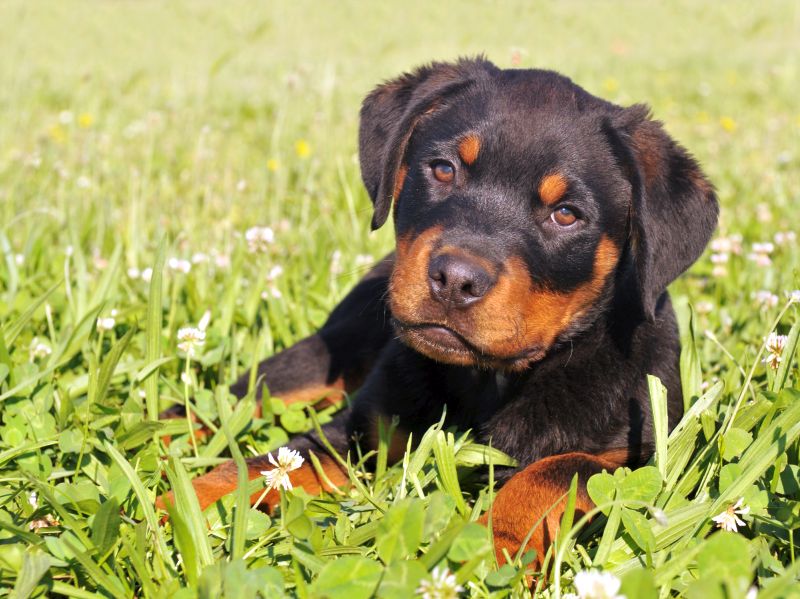
Most airlines have restrictions that prevent puppies under a certain age from flying.
Delta, for example, requires all puppies to be older than 10 weeks before flying domestically, and your puppy must be at least 16 weeks old to venture to most international destinations.
Young puppies are fragile, particularly those with blood sugar issues. Many are still undergoing their core vaccinations, too, leaving them vulnerable to illness. So, whenever possible, let these little ones stay home.
Airlines typically don’t have a maximum age limit for dogs, but they do require the health certificate we mentioned. Seniors often have health issues that can complicate travel and may lead to your vet refusing to grant the certificate.
4. Verify That Your Pet’s Breed Is Allowed to Fly

Some airlines ban certain breeds from traveling in the cabin. Others may ban a breed entirely, including for cargo travel.
Banned breeds often include flat-faced breeds like pugs and bulldogs due to potential breathing issues. Other breeds, such as “bully breeds” like pit bulls and Staffordshire terriers, are banned due to their propensity for overheating easily.
Some airlines ban any breed with a less-than-ideal reputation, as well as any large-sized breeds like German shepherds, Dobermans, Akitas, and other XL canines.
Always confirm an airline’s breed policy before booking your flight. Be sure to specify where your dog will be traveling, as cargo and cabin rules can differ.
5. Know Your Destination’s Pet Laws
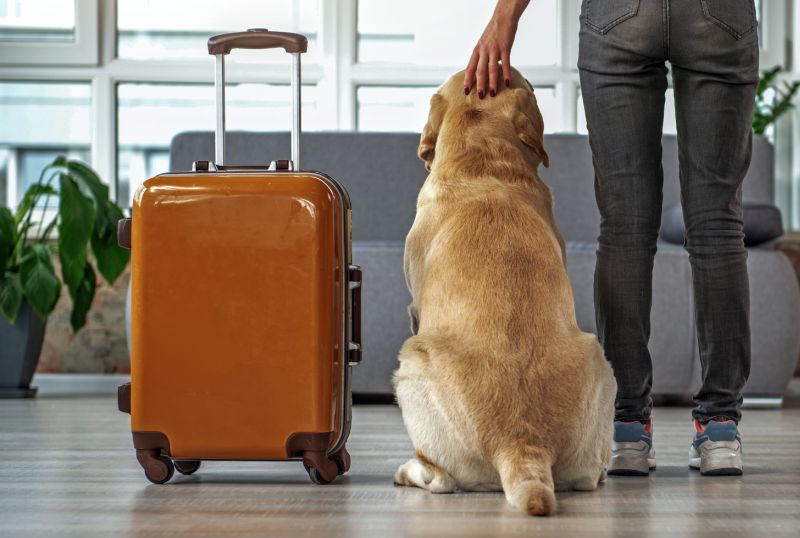
You can’t just show up in most places with a dog, particularly if you’re traveling internationally.
Every jurisdiction has its own laws regarding non-resident canines, encompassing everything from vaccinations to licensing to housing.
For example, you may be traveling for a two-month vacation in a city that requires all dogs to have a license if staying for more than 30 days.
Quarantines may apply if you’re traveling internationally with your dog. These laws aim to prevent the spread of disease and may require your dog to stay at a facility upon arrival for a predetermined amount of time.
Keep in mind that laws are stricter regarding pets flying into the U.S. from countries with high instances of rabies. They may be banned entirely or need to meet a strict requirements checklist.
Research laws in advance to make sure you’ll comply with your pupper. You don’t want to risk fines or canine confiscation.
6. You’ll Want to Book Your Flight Well in Advance
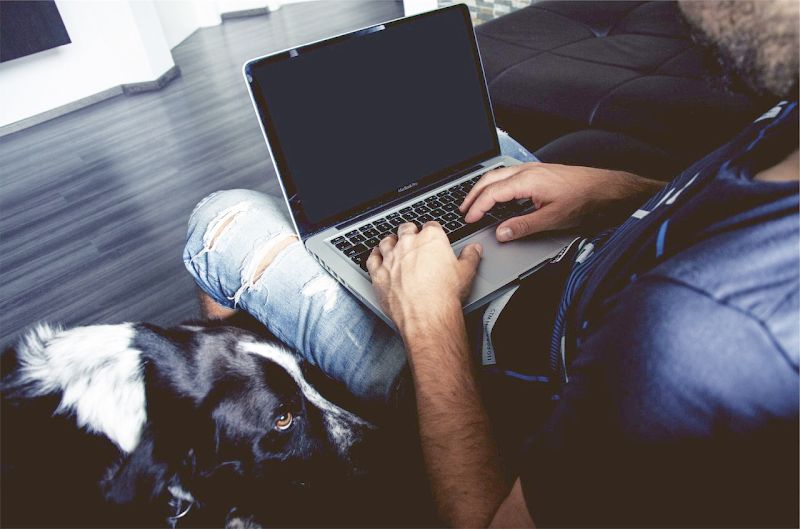
We all know flights book up fast, but it’s trickier to land the right flight when you’re flying with a four-footer.
Will you grab a red-eye flight to travel when he usually sleeps? How about a midweek flight that might be a little less crazy?
Airlines also only allow a designated number of animals per flight, leaving booking options even slimmer. Further complicating things, airlines often restrict where people with carry-on canines can sit, so you’ll have fewer seat options from the start.
Book a few months in advance to nab the best flight plan for you and your dog. This gives you the most options. It may help you score a coveted direct flight too, which we’ll sink our teeth into more below.
If you’re in a pinch and can’t find accommodations that work with your schedule, you can opt for a pet transport service to safely tote your pooch to your destination separately.
7. Pick Your Flight Carefully And Avoid Layovers
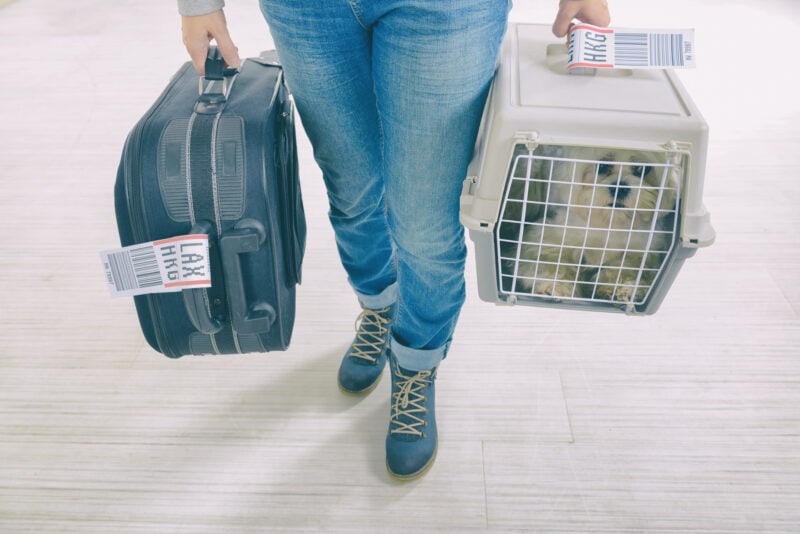
Layovers are always a drag, but they can be particularly problematic if you’re traveling with a dog.
Suddenly, you have to unload your fur kid in a strange airport and wait for your next flight while simultaneously having a four-legged friend who needs to potty and eat.
And that’s if things go exceedingly smoothly and you have plenty of time. If your flights are back-to-back, you have to do all that at warp speed.
Never mind that if your dog is flying in cargo, you have to worry about him safely making it from your first plane to the next.
That’s not a risk most pup parents are willing to take!
For that reason, always try to book direct flights to your destination if possible when traveling with your dog. It eliminates those crazy variables and involves less stress overall on you and your dog.
If your dog is flying cargo, make sure to choose flight times when the temperatures will be most agreeable. For summer months, that might mean booking early morning and late evening flights, while in the winter you’ll want to opt for the middle of the day when temps are at their highest.
8. Look at Your Budget and Consider the Costs
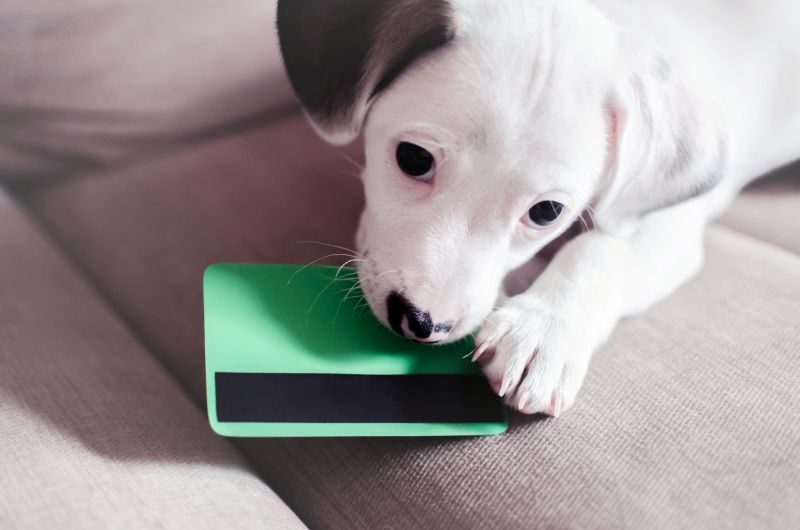
Flying with your dog isn’t cheap, so you might need to cut into your fun fund for vacation – especially if he’s a big doggo.
Generally, costs start at around $100 to fly domestically with your canine in the cabin, but this price can skyrocket if you’re flying with a large dog in the cargo area or traveling internationally.
Cargo fees vary by your dog’s crate size and weight at check-in, so budgeting the cost can be tough. Some airlines, including American Airlines, have online calculators to help estimate the cost. Still, pad your budget to pad for any surprises.
9. Determine If Your Dog Is Traveling via Cabin or Cargo
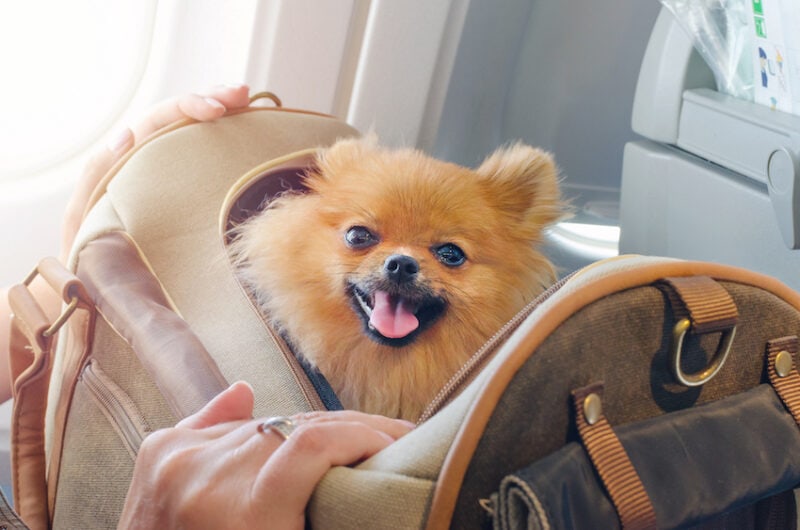
Rules vary by airline, but for the most part, cabin-riding canines need to be small enough to tote in a dog carrier that can be stowed under the seat in front of you.
This is actually why so many of the best dogs for travel are pint-sized.
Traveling in the cabin is almost always less anxiety-inducing for you and your dog than sitting in the cargo section, but it isn’t without its problems. For one, some dogs bark incessantly when crated, upsetting other passengers. Your dog might also have an accident in the carrier, leading to unpleasant smells.
Cabin carrier restrictions don’t apply to service dogs, but we still recommend contacting the airline ahead of time to ensure your seating arrangements work best for you and your service pooch.
Unfortunately, in most cases, medium and large-sized breeds are forced to travel in the plane’s cargo area with luggage. Cargo-flying canines must be housed in an airline-approved crate.
While many dogs travel this way without issue, it’s not always pleasant. It’s loud, traumatic, and can even be downright dangerous for some dogs, so think carefully about how your dog will travel.
Some airlines have better track records when it comes to flying with dogs than others. If you’re not sure who to fly with, consider checking out our list of the best pet-friendly airlines to fly with a dog!
10. You’ll Need to Purchase a Crate or Carrier
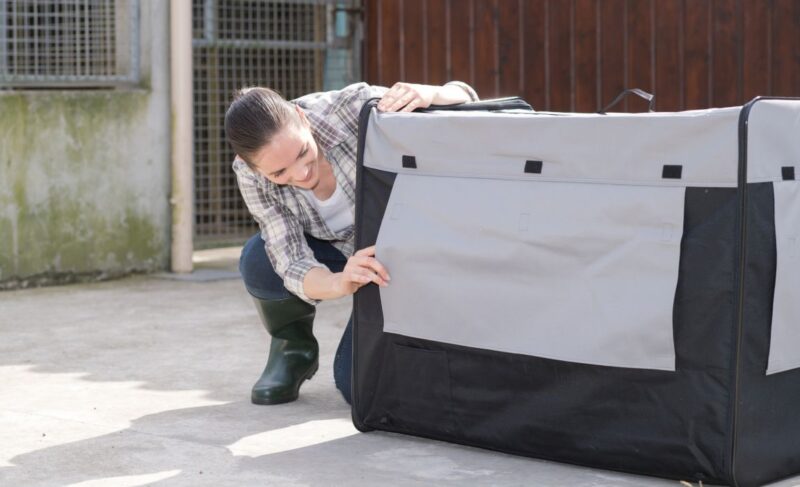
Airlines require specific types of carriers to ensure safe and secure travel.
These requirements differ for dogs traveling in the cabin versus traveling via cargo. Always check that a carrier is compliant with International Air Transport Association standards before purchase.
Cabin carriers may be soft-sided and made of nylon, or they can be plastic. They should be leak-proof and feature adequate ventilation through breathable mesh panels or a grated door and air holes. Most importantly, they must meet specific size requirements to ensure they’ll fit under airplane seats.
Most cargo crates are made of plastic, but fiberglass, metal, welded wire mesh, and wood are also acceptable. The sides and roof must be solid, and the carrier must feature at least 16% surface area ventilation and a leak-proof bottom. The crate must be large enough for your dog to stand, sit, lie down, and turn around comfortably.
A cargo crate needs a functioning door that your dog cannot bend and should feature a locking mechanism that your dog can’t unlatch. Some crate doors must have additional securing via cable ties before takeoff, depending on construction.
Among the many other requirements, carriers must have handles and not feature wheels.
As you can see, there are a lot of must-haves in an airline crate or carrier. Your best bet is to purchase an airline-approved dog crate for cargo travel or airline-approved dog carrier if your pup is flying in the cabin. These come at varying price points based on size and materials but expect to spend at least $50 on a carrier and $60 on a crate for a small-sized dog.
11. You’ll Want to Acclimate Your Dog to the Kennel
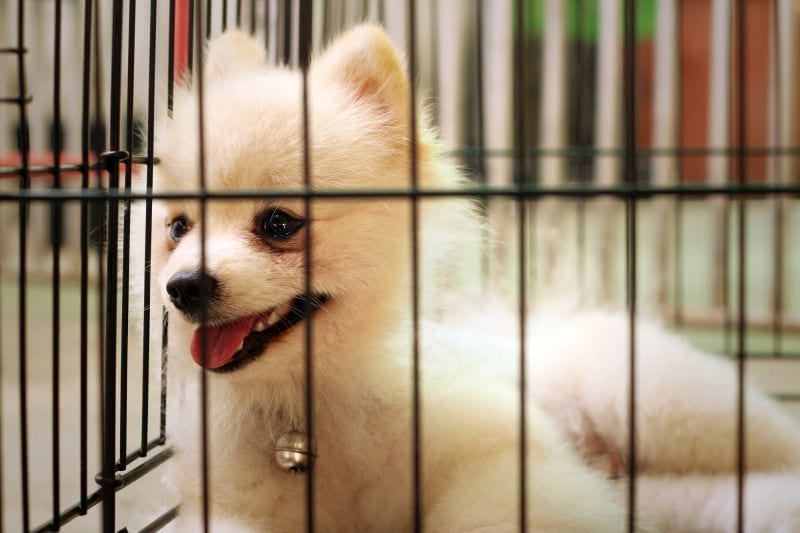
A major way to reduce canine stress during a flight is by introducing your four-footer to his travel crate or kennel in advance.
This is easiest for dogs accustomed to crate training, but most pups can adapt with patience and positive reinforcement.
Unbox the carrier and let your dog check it out with the door open. Most pups will at least sniff it, but brave doggos may even wander inside. Be sure to leave some tasty treats or a chew in the carrier, enticing him inside. Let him enter on his terms to get the reward.
The goal is to associate the crate with something positive.
An easy exercise is to have your dog “place” in the crate for a chew or treat every day. It also helps to put your dog’s bed or toys in the crate to encourage him to hang out inside of it.
Do this with the door open for a while, and work up to closing the door behind him and walking away. From there, you’ll want to do test drives with your dog in the crate that mimics the airport and airplane environment as closely as possible. You can put your pup into the cargo area of a van, go through car washes, etc.
This helps him adjust to spending time in his crate so it won’t be such a big deal on travel day.
Patience and positivity are your best friends when introducing your dog to a crate. Never use the crate as punishment. It should be a hound haven, not a timeout zone.
12. Pack Everything Your Dog Needs

Make a list of must-have items for your dog and check over it twice before leaving the house.
Your list should include the basics like dog food, poop bags, medication, a leash, and the oddball things you might forget like a spare leash, chews, or a brush. Don’t go too overboard with toys, but bring your dog’s favorites for a piece of home while you’re away.
Also, make sure that your dog’s collar or harness features a tag with current information.
Package your dog’s medication in your carry-on to avoid a lost bag nightmare. Remember to keep them in their designated pharmacy containers with your dog’s name and the medication name clearly labeled.
13. Prepare for Your Specific Destination
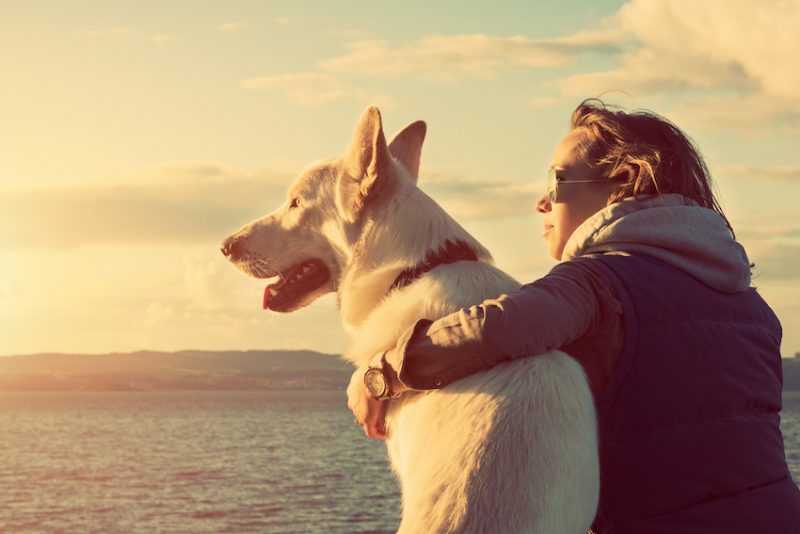
The hurdles aren’t over once you’re safely on the ground after your flight.
Depending on your destination, you may need to deal with quarantines or other animal travel hiccups. Then you have to get your dog to your ultimate destination with you, which means you may have to schedule a dog-friendly taxi in advance. You might need to book a travel van if your dog’s airline crate is large.
Research vets in your destination just in case anything pops up while you’re away. Obviously, you hope not to use this information, but it’s important to have it on standby. Save the information of both regular and emergency vets in your phone to make it easy to find if need be.
Also, make sure your dog’s flea and tick preventative is current before traveling. This prevents creepy crawlies from hitching a ride on your dog during transit and is a must-have in wooded destinations.
Don’t forget about your dog’s heartworm preventative, either. Mosquitoes are nothing you want to mess around with, and they’re very common in some travel destinations.
14. You’ll Likely Want to Skip the Sedatives

Sedatives used to be the go-to for traveling with anxious dogs, but attitudes have changed due to serious safety concerns.
Unfortunately, while sedatives provide much-needed calming for some dogs, they can also affect breathing and body temperature regulation. This can spell disaster in an airline crate or carrier.
Some dogs need these anxiety medications to travel safely, but speak to your vet about the risks, even with over-the-counter calming supplements.
Your vet may be able to prescribe canine anxiety medication to help calm your pup’s nerves, but that may not be safe depending on your dog’s previous experience with meds, the dog’s breed, and whether the pup will be in the cabin or the cargo area of the plane.
15. Feed Your Pup an Appropriate Amount of Time Before Takeoff

Feeding Fido while traveling will require some adjustments to your normal schedule.
Keep meals light the day of travel, and don’t feed your dog within four hours of takeoff. This window is crucial for avoiding motion sickness and mid-flight accidents.
We know it feels mean, but most dogs can go up to 10 hours without food. You’d much rather your fur kid be a little hungry upon landing than covering in poop or vomit, right?
Obviously, this isn’t always possible for dogs with certain medical conditions. In that event, discuss a feeding plan with your vet ahead of time.
This is the time to stick to your pup’s everyday diet – don’t give him any new food or treats while traveling. You don’t want to discover that his new chew causes explosive poops right before your flight.
The mess isn’t just unpleasant; it can also lead to your dog being barred for signs of illness, even if it’s just diarrhea from a sour sausage.
16. Give Your Dog Some Preflight Play Time
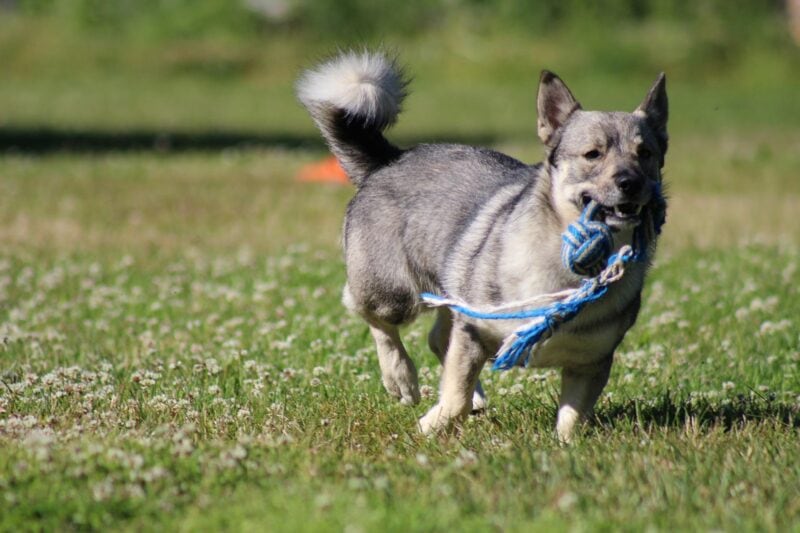
Playtime for pups isn’t just for fun – it’s an important part of overall canine care.
Spending hours in a crate or carrier isn’t fun for your pooch. Sure, it’s mentally exhausting, but your pup’s body can get stiff and uncomfortable in such a confined space. He can also suffer from pent-up energy and frustration.
An easy way to lessen these effects is to have fun before takeoff. Enrichment activities that combine mental and physical exercise are best, such as sniffari walks, games of fetch, or hide-the-treat games.
You don’t want to wear your dog out too much or risk injury with an out-of-the-ordinary marathon run, but you want to get his mind and body pumping.
A good rule of thumb is to provide at least 20 to 30 minutes of moderate play, adjusting more or less based on your dog’s age and exercise needs. For example, a husky will probably need more of a workout than a pug.
17. Seek Out the Pet Relief Areas Before You Fly

Always give your dog ample time to do his business prior to takeoff to avoid a smelly surprise at 30,000 feet. Try to walk out that last pupper poop, and let your man-mutt lift his leg to his heart’s content in designated relief areas.
Most (if not all) airports have dog relief areas. To save time and aggravation, look these up in advance for each stop on your journey. And remember to pack potty bags for easy cleanup.
18. Understand That Your Dog May Be Anxious After Flying
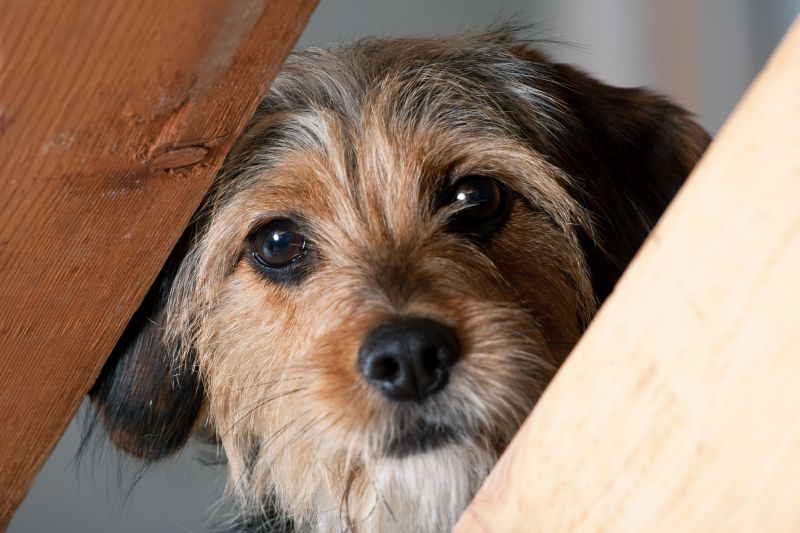
Post-flight anxiety can leave your dog feeling unsure, so use caution when retrieving your pet from his carrier or crate.
Among other things, your dog may bolt unexpectedly or refuse commands. But he may also act in myriad other strange ways.
For this reason, we advise only opening his carrier in a secure area and keeping him leashed when he’s out of the carrier for potty breaks. This is most likely the law in any area, but it’s also the safest option.
Expect some post-flight whining or clinginess while your dog adjusts. Most dogs settle down in a day or two, but others may need a touch longer. Some also experience anxiety-related diarrhea during this span. If the diarrhea is severe or seems illness-related, contact your vet.
19. Your Dog Will Be Tired After Flying
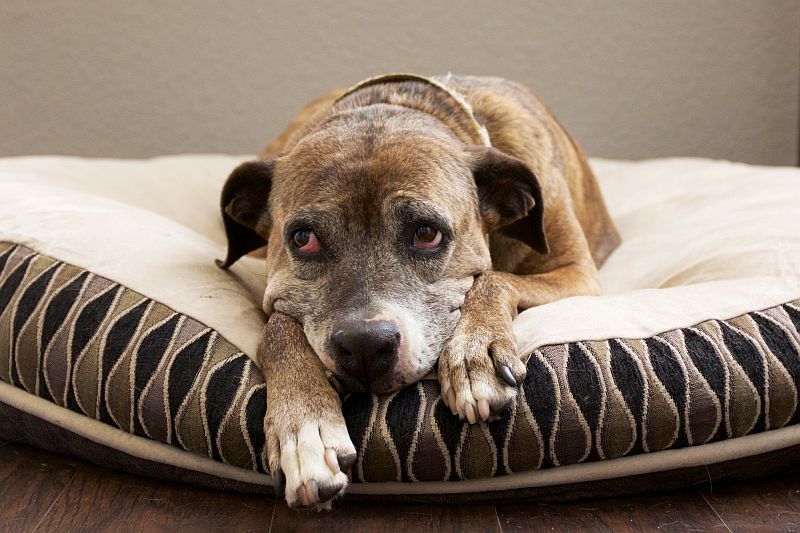
Humans aren’t the only ones needing a nap after flying. Your canine may need to crash on the couch for a day or two to unwind.
Flying is a shock to your dog’s system. The uncertainty of traveling in a plane alone is tiring, but factor in possible time zone differences, traveling to and from the airport, and arriving at a new (possibly strange) destination, and it’s doggone exhausting.
Flying forces your dog’s mind and body to run in a go-go-go setting for an extended period. You’d need a minute to relax, too, after that much craziness.
Be patient with your pup while he recovers from all the excitement. Don’t push him to try too much at once if he’s weary, particularly with older dogs and puppies who may need a little more time to catch up on sleep.
Give your vet a call if you notice any signs of illness outside of expected fatigue, however. You want to make sure he didn’t pick up any ickies as a high-flying hound.
***
Have you ever flown with your floof? Have any tips for newbie travelers with dogs? Share with us in the comments. We’d love to hear.

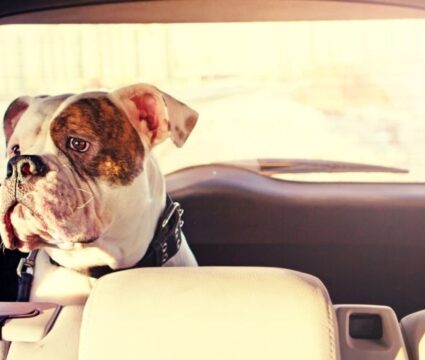




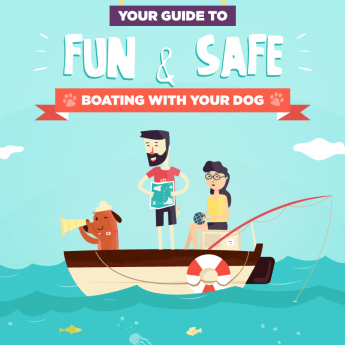
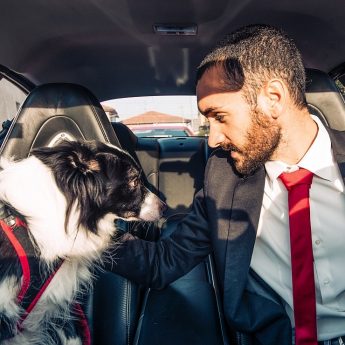
No Comments